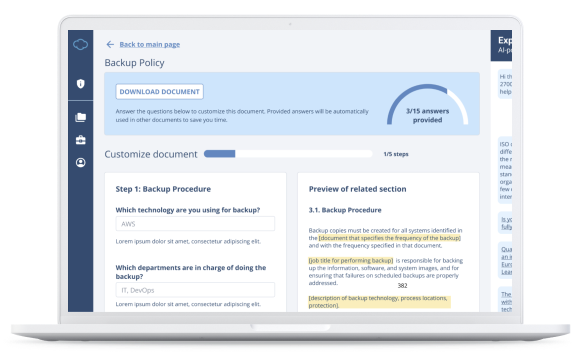Updated on March 6, 2024 (transposition in Member States)
If your company is preparing to be compliant with NIS 2, you’re probably wondering what you have to do. This article presents the most important NIS2 requirements to comply with, with the main focus on Chapter IV — Cybersecurity risk-management measures and reporting obligations.
- Responsibilities of senior management
- Importance of training
- Risk-based approach to cybersecurity
- Cybersecurity as a mixture of technical, operational, and organizational measures
- Supply chain security
- Reporting of significant incidents
- Using certified IT products and services
- Fines
Surprisingly, out of 46 articles in the NIS 2 Directive, only articles 20 to 25 are really relevant for companies (i.e., essential and important entities) that must become compliant with NIS 2; most of the other articles specify the requirements for government bodies that regulate cybersecurity.
See also: 16 implementation steps for NIS 2 cybersecurity risk management measures
These most important requirements are placed in Chapter IV, and they revolve around two main topics: cybersecurity risk management and reporting obligations. Besides Chapter IV, there are only a few requirements relevant for essential and important entities.
So, here are the most important NIS 2 requirements you should be aware of:
1) Responsibilities of senior management
According to Article 20, the top management of essential and important entities:
- must approve cybersecurity measures that need to be implemented in the company,
- must oversee their implementation, and
- can be held liable if cybersecurity is not implemented properly.
Articles 32 and 33 further emphasizes the liability of the legal representatives of essential entities and important entities.
2) Importance of training
According to Article 20, members of top management must go through cybersecurity training, and they must enable their employees to attend such training on a regular basis.
NIS 2 requires such training to cover identification of risks, assessment of cybersecurity practices, and how these cybersecurity measures help the company provide its services.
Click here to see 25 security awareness videos to train the employees in your company.
3) Risk-based approach to cybersecurity
Article 21 requires cybersecurity measures to be appropriate for the related risks; when assessing the risks, NIS2 requires companies to take into account the following:
- exposure to risks
- company size
- likelihood of occurrence of incidents and their severity
- societal and economic impacts of incidents
4) Cybersecurity as a mixture of technical, operational, and organizational measures
Article 21 requires companies to “take appropriate and proportionate technical, operational and organisational measures to manage the risks posed to the security of network and information systems … and to prevent or minimise the impact of incidents on recipients of their services and on other services.”
Further, Article 21 requires an all-hazards approach, which basically means that companies have to prepare for a wide range of potential threats.
Finally, Article 21 specifies a range of cybersecurity documents and measures, which are listed in this article: List of required documents according to NIS 2.
5) Supply chain security
Article 21 requires companies to pay special attention to risks related to direct suppliers and service providers, in particular:
- Vulnerabilities specific to each direct supplier and service provider
- The overall quality of products and cybersecurity practices of suppliers and service providers
- Secure development procedures of suppliers and service providers
6) Reporting of significant incidents
Article 23 requires companies to report any significant incidents to computer security incident response teams (CSIRTs) in the following way:
- An early warning — indicates whether the significant incident is suspected of being caused by unlawful or malicious acts or could have a cross-border impact.
- An incident notification — provides an initial assessment of the significant incident, including its severity and impact, as well as, where available, the indicators of compromise.
- An intermediate report — provides relevant status updates.
- A final report — needs to be created, at the latest, one month after the submission of the incident notification.
- A progress report — is created in the event of an ongoing incident at the time of the submission of the final report.
See also: What are reporting obligations according to NIS 2?
7) Using certified IT products and services
NIS 2 does not require essential and important entities to get certified. However, the NIS2 Directive allows for EU countries (Member States) or the EU Commission to require those entities to use IT products or services that are certified. At the time of writing this article, there are no requirements for using certified IT products or services, but there is a high chance that this will become mandatory.
Those IT products and services will need to be certified according to the European cybersecurity certification scheme.
8) Supervision and fines
NIS2 requires a strict oversight over essential and important entities: on-site inspections, off-site supervision, cybersecurity audits, and security scans.
Similar to the EU GDPR, Article 34 introduces fines for companies that do not comply with NIS 2:
- For essential entities: a maximum of 10 million EUR or a maximum of 2% of the total worldwide annual turnover.
- For important entities: a maximum of 7 million EUR or a maximum of 1.4% of the total worldwide annual turnover.
Judging from experience with the EU GDPR, in the first year or two of coming into effect, no large penalties tend to be levied against companies; however, lately, such fines are quite common.
Additional legislation from EU countries
Unfortunately, the story does not end here – EU countries (Member States) can introduce their own cybersecurity and reporting requirements on top of what NIS 2 prescribes. This process of adopting local legislation based on an EU directive is called “transposition.”
As of the date of writing this article, the following Member States have transposed NIS 2 into their local legislation:
- Overview of Croatia’s NIS2 Cybersecurity Regulation
- What are additional requirements of Croatia’s Cybersecurity Act when compared to NIS 2?
- Overview of Lithuania’s Decision on Cybersecurity Requirements
- What are the additional requirements of Lithuania’s Cybersecurity Act when compared to NIS2?
- Overview of the Italian NIS2 law and comparison with the EU NIS2 Directive
- What are the additional requirements of Belgium’s cybersecurity law when compared to NIS 2?
- Overview of Latvia’s Cybersecurity Law and Comparison with the NIS2 Directive
As is the case with Croatia’s Cybersecurity Act, most Member States probably won’t introduce bigger new requirements, however some smaller extra requirements can be expected – in any case, I’ll update this article when that happens
To find all the documents needed for complying with the NIS 2 Directive, check out this NIS 2 Documentation Toolkit that includes all policies, procedures, plans, and other templates.

 Dejan Kosutic
Dejan Kosutic

